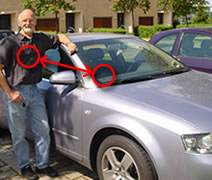
| 9.3 The Possessive Object - Genitive |
 |
The second picture shows the relation between two objects.
The car belongs to the man who is right next to the
door. The possessing of something is described with
the Genitive. In English the Genitive is formed with a
preposition.
| das Auto des Mannes = the car of the man |
The German language uses a declination not a preposition:
![]()
| article | noun | prep. | arti. | noun |
| das | Haus | - | der | Frau |
| the | house | of | the | woman |
Since the Germans don't use a preposition, they have
to have another way of noticing what kind of relation
is between the woman and the house. Have a look at the
definite articles:
| das Haus der Frau it is der Frau in Genitive not die Frau (like in basic form) This der Frau corresponds to of the woman |
We have to admit that the English system is much easier
as the table below shows. However there is nothing we
can do to make it easier.
| declination in German and the English system |
| das |
Haus | - | der | Frau | Nominative: die Frau Genitive: der Frau |
| the | house | of | the | woman | preposition de |
| das |
Haus | - | der | Frauen | Nominative: die Frauen Genitive: der Frauen |
| the | house | of | the | women | preposition de |
| das
|
Haus | - | des | Mannes | Nominative: der Mann Genitive: des Mannes |
| the | house | of | the | man | preposition of |
| das |
Haus | - | der | Männer | Nominative: die Männer Genitive: der Männer |
| the | house | of | the | men | preposition of |
| das |
Haus | - | des | Kindes | Nominative: das Kind Genitive: des Kindes |
| the | house | of | the | child | preposition of |
| das |
Haus | - | der | Kinder | Nominative: die Kinder Genitive: der Kinder |
| the | house | of | the | children | preposition of |
For the object in Genitive you ask: Whose? or Of which?
Whose car is it? my fathers.
The door of this house.
the door of which? of the house.
| contact privacy statement imprint |